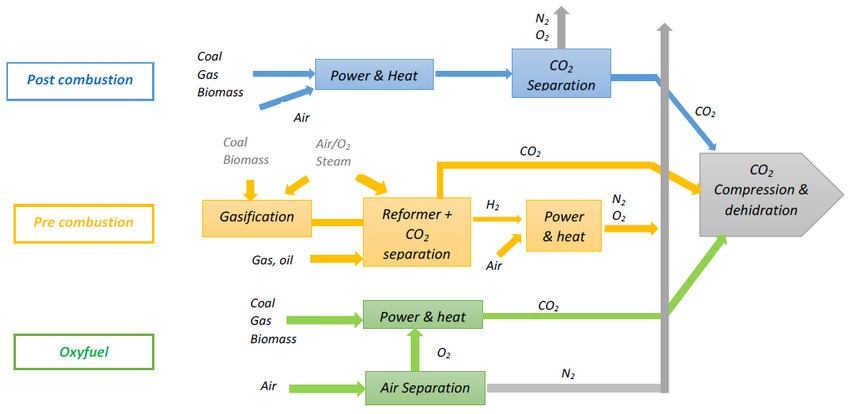Air Pollution
Carbon Capture & Storage (CCS)
Ashley Halim, Rei, Rinoa Salsabila
May 13, 2024
Introduction to the Concept of Carbon Capture & Storage (CCS)
Carbon Capture and Storage is a technology for capturing and storing carbon to reduce emissions such as CO2 into the atmosphere. This technology is implemented by storing greenhouse gas emissions generated from the use of fossil fuels, which are then processed in industrial plants to prevent emissions from being released into the atmosphere. Therefore, CCS is considered important in addressing the issues of climate change and global warming, which are caused by increasing carbon emissions due to the development of the industrial sector in Indonesia.
CCS Stages

The main stages in the CCS process are divided into three parts: capture, transportation, and storage. In the capture process, CO2 is separated and captured from emission sources. In this capture process, there are also three types of CO2 capture: Pre-combustion, which involves capturing CO2 before combustion by processing the primary fuel with steam and air, or with oxygen in a reactor to produce a mixture mainly consisting of CO and H2.
Then there is Post-combustion, a process of separating CO2 gas from the flue gas resulting from the combustion of the main fuel in air, by capturing 3–15% of the CO2 volume present in the flue gas stream. The main constituent of the flue gas is nitrogen, and the separation is done using liquid solvents (IEA, 2013, IPCC, 2005).
Next is Oxy-fuel Combustion, a process of combustion using pure oxygen to produce exhaust gases that mostly consist of water vapor (H2O) and CO2 (with CO2 concentrations exceeding 80% of the total gas volume). The process involves cooling and compressing the gas stream to remove water vapor. This system requires the separation of oxygen from air with a purity level of 95–99%, and further treatment is needed to remove air pollutants and non-condensable gases (such as nitrogen) from the CO2 exhaust gas before it is sent for storage.
The next part of the main CCS process is transportation. The CO2 captured during the capture process is transported to the storage site via a network of pipelines. Finally, the last main process in CCS is storage. The location for storing the captured CO2 gas must be determined, such as geological formations, deep-sea sites, salt-layered aquifers, and empty oil and gas reservoirs located at least 1 km (0.6 miles) below ground.
The Situation in Indonesia
According to the Kyoto Protocol convention, Indonesia is classified as a non-Annex I member, meaning it is not obligated to reduce emissions. Therefore, the implementation of CCS is not a mandatory requirement. However, during COP-13 in Bali at the end of 2007, it was agreed that Indonesia would undertake significant CO2 emission reductions. In practice, there are currently 16 CCS/Carbon Capture, Utilization, and Storage (CCUS) projects in Indonesia that are still in the study and preparation stages.
Most of these projects are targeted to be operational before 2030, and the Indonesian government has issued Ministerial Regulation of Energy and Mineral Resources (ESDM) No. 2 of 2023 concerning the Implementation of CCS/CCUS Activities, which regulates technical aspects, business scenarios, regulations, and economics. This commitment is further strengthened by the enactment of Presidential Regulation No. 14 of 2024 concerning the Implementation of Carbon Capture and Storage Activities.
Benefits of CCS
CCS/CCUS activities also provide a number of benefits for countries that implement them, beyond simply reducing carbon emissions. These benefits include boosting the economy, increasing oil and gas production, investment capacity, and technological development to support CCS/CCUS activities.
References
- https://www.britannica.com/technology/carbon-capture-and-storage
- Prasetyo, A. W., & Windarta, J. (2022). Pemanfaatan Teknologi Carbon Capture Storage (CCS) dalam Upaya Mendukung Produksi Energi yang Berkelanjutan. Jurnal Energi Baru dan Terbarukan, 3(3), 231-238.
- https://www.esdm.go.id/id/media-center/arsip-berita/carbon-capture-and-storage-6-implementasi-ccs-di-indonesia
- https://www.esdm.go.id/id/media-center/arsip-berita/16-proyek-ccs-ccus-ditargetkan-beroperasi-sebelum-2030
- https://www.esdm.go.id/id/media-center/arsip-berita/demi-kejar-target-net-zero-emissions-lemigas-dorong-implementasi-ccs-ccus
- https://www.pertamina.com/id/news-room/news-release/carbon-capture-storage-ccs-sebagai-pendorong-perekonomian-indonesia-memanfaatkan-potensi-untuk-masa-depan-hijau
- https://migas.esdm.go.id/post/read/kuatkan-kerangka-peraturan-ccs-indonesia-optimis-jadi-ccs-hub-asia-tenggara
- https://www.esdm.go.id/id/media-center/arsip-berita/carbon-capture-and-storage-6-implementasi-ccs-di-indonesia